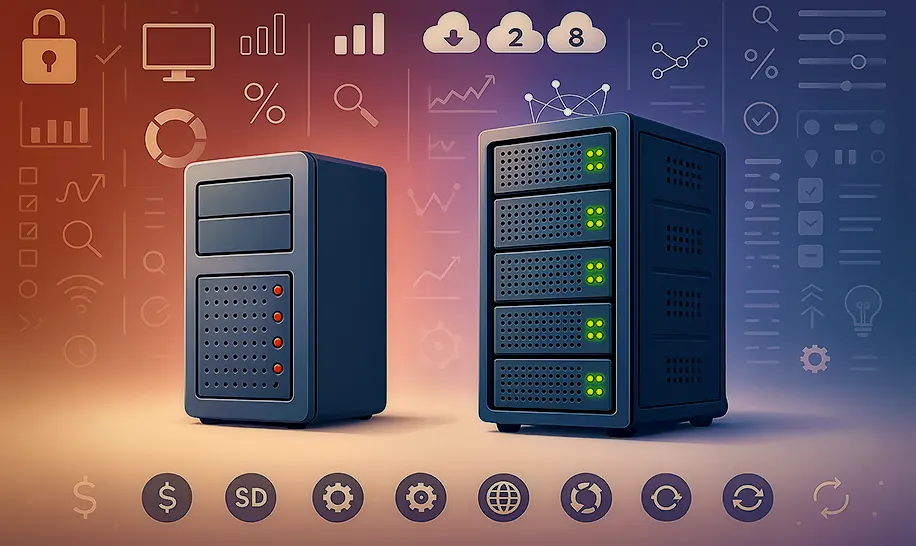
Low Cost vs High Cost Servers: What's the Real Difference?
Choosing the right server infrastructure is one of the most critical decisions any business or individual with an online presence will make. Get it right, and you have a stable, performant foundation for growth. Get it wrong, and you could face a cascade of issues, from frustrating downtime to crippling security breaches. A central question in this decision often boils down to: should I opt for a low-cost server or invest in a high-cost one?
The answer, as with many things in tech, is: "it depends." But what exactly are you paying for (or saving on) when you choose one over the other? Let's dive deep into the real differences, the pros and cons, and when each type of server truly shines.
Beyond the Price Tag: Understanding "Cost"
Before we dissect the servers themselves, it's crucial to understand that "cost" isn't just the monthly or annual fee. We need to consider the Total Cost of Ownership (TCO). This includes:
- Upfront Hardware/Setup Costs: The initial investment.
- Recurring Fees: Monthly/annual hosting or subscription fees.
- Management & Maintenance: Time spent by your team (or paid support) on setup, patching, troubleshooting, and upgrades. This is a significant hidden cost for unmanaged, low-cost options if you lack expertise.
- Downtime Costs: Lost revenue, productivity, and reputation damage when your server is offline.
- Performance Costs: Slow loading times can lead to lost customers and poor user experience.
- Security Costs: The potential financial and reputational fallout from a security breach.
- Scalability Costs: The expense and effort required to upgrade resources as your needs grow.
With this broader definition of cost in mind, let's explore the two ends of the server spectrum.
Low-Cost Servers: The Budget-Friendly Workhorses
Low-cost servers often come in the form of shared hosting, basic Virtual Private Servers (VPS), or older/refurbished dedicated servers. They are designed to provide essential server functionalities at the most affordable price point.
What Defines a Typical Low-Cost Server?
- Shared Resources (in many cases): Particularly with shared hosting, you're sharing CPU, RAM, and network bandwidth with many other users on the same physical machine. Basic VPS plans might also have contended resources.
- Older or Less Powerful Hardware: CPUs might be a few generations old, RAM might be non-ECC (Error-Correcting Code), and storage might be traditional HDDs or slower SATA SSDs.
- Limited or Basic Support: Support might be ticket-based with longer response times, or primarily community-driven. Phone support or dedicated account managers are rare.
- Fewer Redundancies: Less likely to have redundant power supplies, network connections, or sophisticated RAID configurations for storage.
- Minimal Managed Services: You're often responsible for OS updates, security patching, backups (or they are very basic), and software installations.
- Less Robust SLAs (Service Level Agreements): Uptime guarantees might be less stringent or have more exceptions.
Pros of Low-Cost Servers:
- Affordability: This is the primary draw. Startups, personal projects, and small businesses with tight budgets can get online without a hefty initial investment.
- Accessibility: Easy to sign up for and often come with control panels (like cPanel or Plesk) that simplify basic management tasks.
- Good for Learning & Development: Perfect for developers learning server administration, testing new applications, or hosting non-critical staging environments.
- Sufficient for Simple Needs: A personal blog, a small portfolio website, or a low-traffic informational site can run perfectly well on a low-cost server.
Cons of Low-Cost Servers:
- Performance Limitations: Shared resources can lead to the "noisy neighbor" effect, where another user's high demand impacts your site's speed. Older hardware naturally offers less processing power.
- Reliability Concerns: Higher chance of downtime due to hardware failure (single points of failure) or overloaded shared environments.
- Limited Scalability: Upgrading resources can be difficult, involve downtime, or require migrating to an entirely new, more expensive plan.
- Security Risks: While providers offer basic security, you're often more responsible for hardening your server. Shared environments can sometimes pose a slightly higher risk if one account is compromised.
- Basic Support: When things go wrong, getting timely and expert help can be challenging, leading to extended downtime.
- Hidden Management Overhead: If you're not technically proficient, managing an unmanaged or lightly managed server can consume a lot of your time, negating some of the cost savings.
When Are Low-Cost Servers a Good Fit?
- Personal Websites & Blogs: Low traffic, non-commercial.
- Startups with Minimal Funding: To get an MVP (Minimum Viable Product) online.
- Development & Testing Environments: Where uptime and peak performance aren't critical.
- Static Websites: Sites with primarily HTML, CSS, and JavaScript content.
- Non-Critical Internal Tools: Small applications used by a few internal users.
- Learning Server Administration: A cheap way to experiment and learn.
High-Cost Servers: The Powerhouses of Performance and Reliability
High-cost servers typically encompass premium dedicated servers with modern hardware, robust managed VPS solutions, or enterprise-grade cloud computing instances. The higher price reflects superior hardware, extensive support, and a greater focus on reliability and performance.
What Defines a Typical High-Cost Server?
- Latest Generation Hardware: Top-tier CPUs (Intel Xeon, AMD EPYC), ample ECC RAM, fast NVMe SSD storage, often in RAID configurations for performance and redundancy.
- Dedicated Resources: Even in virtualized environments, resources are often guaranteed or less over-committed. Dedicated servers offer exclusive use of all hardware.
- Comprehensive Support: 24/7 support via multiple channels (phone, chat, ticket), often with rapid response times and expert technicians. Dedicated account managers might be included.
- High Redundancy: Redundant power supplies, network interfaces, enterprise-grade cooling, and often geographically diverse data centers.
- Managed Services: Providers often handle OS patching, security updates, backups, monitoring, and sometimes even application-level support.
- Strong SLAs: Robust uptime guarantees (e.g., 99.99% or higher) with clear compensation if breached.
- Advanced Security Features: Built-in DDoS protection, web application firewalls (WAFs), intrusion detection systems, and regular security audits.
- Scalability Options: Easier and often seamless scaling of resources (CPU, RAM, storage) with minimal or no downtime.
Pros of High-Cost Servers:
- Superior Performance: Capable of handling high traffic, complex applications, and large databases with speed and efficiency.
- Exceptional Reliability & Uptime: Designed to minimize downtime through redundancy and proactive monitoring, crucial for business-critical applications.
- Enhanced Security: Better hardware and software security measures, along with expert support, reduce the risk of breaches.
- Excellent Support: Quick and knowledgeable assistance when you need it most, saving you time and stress.
- Scalability & Future-Proofing: Can easily adapt to growing business needs without major disruptions.
- Peace of Mind: Knowing your infrastructure is robust, secure, and well-supported allows you to focus on your core business.
- Managed Services Save Time: Offloading server management tasks frees up your IT team or your own time for more strategic initiatives.
Cons of High-Cost Servers:
- Higher Upfront and Recurring Costs: The most obvious drawback. This can be a significant barrier for smaller entities.
- Potential for Over-Provisioning: You might pay for resources or features you don't fully utilize, especially if your needs are modest.
- Complexity (Sometimes): While often managed, the sheer number of features and options can sometimes be overwhelming if you're not familiar with them.
When Are High-Cost Servers Essential?
- Mission-Critical Applications: Any application where downtime directly translates to significant lost revenue, customer trust, or operational disruption (e.g., e-commerce, SaaS platforms, financial services).
- High-Traffic Websites & Applications: Sites expecting thousands or millions of concurrent users.
- Large Databases & Data-Intensive Workloads: Applications requiring fast data processing and I/O.
- Compliance & Regulatory Requirements: Industries like healthcare (HIPAA) or finance (PCI DSS) often necessitate specific security and infrastructure standards met by higher-cost providers.
- Businesses Where Reputation is Paramount: Consistent performance and uptime build trust.
- Organizations Lacking In-House IT Expertise: Managed services can bridge the technical gap.
- When the Cost of Downtime Exceeds the Cost of the Server: A simple calculation that often justifies the investment.
Making the Right Choice: It's All About Your Needs
The "real difference" isn't just about faster chips or more RAM; it's about the entire ecosystem surrounding the server – from the quality of components to the expertise of the support team and the robustness of the infrastructure.
To decide, ask yourself:
- What is the purpose of this server? (Personal blog vs. e-commerce platform)
- What is my budget, both upfront and ongoing?
- What is the cost of downtime to my project or business? (Crucial!)
- How much traffic and load do I expect, now and in the future?
- What are my technical skills? Can I manage a server myself?
- Are there any specific security or compliance requirements?
- How important is fast, expert support when issues arise?
Answering these questions honestly will guide you. A startup might begin with a low-cost VPS and migrate to a more robust solution as revenue and traffic grow. A large e-commerce site, however, cannot afford to start with anything less than a high-performance, reliable server.
Final Thoughts
There's no universally "better" option between low-cost and high-cost servers. The best server is the one that appropriately meets your specific requirements, budget, and risk tolerance. Don't skimp where it matters most (like on a server hosting your primary income stream), but equally, don't overspend on enterprise-grade features for a personal hobby site. Understand the trade-offs, assess your needs carefully, and choose wisely. Your digital presence depends on it.



